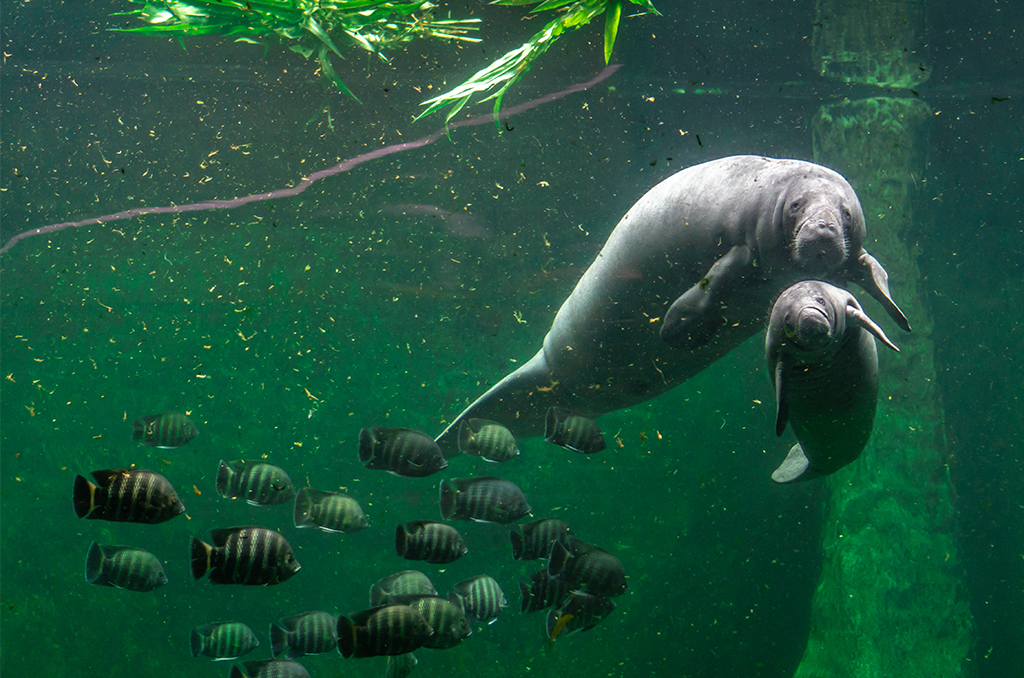Manatees — Courtesy: Shutterstock — Image by: Lukasz Machowczyk
In Florida, an ecological issue has led to the deaths of over 1,000 manatees. The slow-moving marine mammals graze on seagrass in shallow coastal areas, but a massive die-off of seagrass has left them with barely any food to eat.
The lack of food is most prevalent in Indian River Lagoon, a 150-mile-long saltwater estuary where more than 90% of the seagrass, the manatee’s main food source, has died. Just this year, the record number of manatee deaths is 10% of the entire Florida population.
Manatees are extremely susceptible to cold temperatures and gather in the lagoon throughout the winter. In the past, the main threats to them have been collisions with toxic algae, boats, and cold weather.
Starvation became a major factor this year, leading the federal government to designate it as an “unusual mortality event” and join with other conservation organizations and wildlife agencies to respond.
A large amount of starving manatees have been rescued, but Jon Peterson, who leads the rescue operation at SeaWorld Orlando, says rehabilitating an emaciated manatee is a very slow process.
“You slowly stretch the stomach, get it used to food again,” Peterson says. “A starvation event animal, we’re looking at four to nine months before they’re ready to go back out.”
The large number of distressed and emaciated manatees is heavily taxing a network of wildlife agencies, research groups, and zoos that rehabilitate them and eventually reintroduce them into the wild. SeaWorld has made the effort to expand its rehabilitation facilities. Other marine parks and aquariums are also scrambling to add more water space.
Peterson says that manatee rescue teams are bringing in a large number of orphaned calves. Mothers who can’t find a substantial amount of food feed their offspring until they are no longer able to. Rehabilitating orphan calves takes three to four years.
“You’ve got a year of just bottle feeding… every three hours around the clock,” he says. “And then you have to transfer them over to eating lettuce. And once they start eating lettuce more, then you transfer them into understanding that they’re a manatee.” Peterson says the good is that his team has a 96% success rate in caring for and returning them to the environment.
Efforts are underway to improve water quality—addressing issues caused by sewage, fertilizer runoff, and septic tanks in Indian River Lagoon. Restoring the once rich seagrass beds may take years. In the meantime, many want wildlife agencies to begin an emergency feeding program to prevent more deaths from starvation.
“What we’re pressing hard for is to supplement the diet, especially to get those manatees that are already malnourished, and prevent them from reaching the point of starvation,” says Patrick Rose, the executive director of Save the Manatee Club.
That raises questions for wildlife agencies that typically discourage people feeding manatees and other animals found in the wild. But the idea of several hundred more dead manatees has convinced Florida’s Fish and Wildlife Conservation Commission that a supplemental feeding program is needed.
Research still needs to be done to determine what food would be the best options and how it would be delivered. Whichever it may be, it needs to begin soon.
“We may actually be reduced primarily to looking at feeding them much like you do in captivity with lettuce or cabbage or other forms of greens,” he says. “But again, it’s frustrating because we can’t even get this tested yet.”
Asked about plans for manatees, the U.S. Fish and Wildlife Service says that no decision has been made on feeding and that there is no timeline for when a decision is expected to be made.
Are you interested in Florida’s nature? For stories like this and much more: Florida Insider is dedicated to educating, entertaining and informing its readers about everything Florida. Easy to read content at the palm of your hands and covering the stories that matter.

